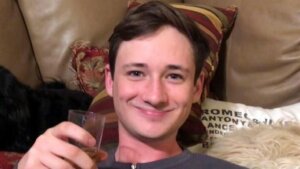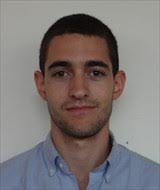Jury convicts Blaze Bernstein’s killer of premeditated murder and a hate crime
Samuel Woodward, Bernstein’s former classmate, will face life in prison without the possibility of parole

Jeanne Pepper and Gideon Bernstein following the conviction of Samuel Woodward on first-degree murder and hate crime charges on July 3. Photo by Louis Keene
SANTA ANA, Calif. – Samuel Woodward was found guilty of first-degree murder and a hate crime Wednesday, condemning the Orange County man who killed gay and Jewish college student Blaze Bernstein in 2018 to life in prison without the possibility of parole.
The verdict — which elicited cheers inside the packed courtroom from friends and family of the victim — concluded the nearly three-month trial of Woodward, a social outcast who was active in the neo-Nazi group Atomwaffen Division when he stabbed his former high school classmate 28 times and buried him in a park. Prosecutors said he lured Bernstein there to kill him — on pretenses of a hookup — to fulfill the bigoted ideology of the group.
Woodward, who testified last month that he killed Bernstein because the victim groped and then threatened to out him that night, was motionless, his face concealed by shoulder-length brown hair, as the verdict was read. Bernstein’s mother, Jeanne Pepper, exclaimed, “Thank God,” and wept. At least one juror could also be seen in tears.
In light of Woodward’s admission, the most likely outcomes appeared to be stake in the trial was whether Woodward would face a minimum of 16 years in prison or life behind bars. And while the jury was asked to determine only whether anti-gay prejudice was a significant motive in the killing, it was allowed to consider antisemitism a factor in premeditation.
Bernstein’s disappearance grew into a national story shortly after his parents reported him missing on Jan. 3, 2018. After his body was discovered at the park a week later, authorities searching Woodward’s room found a folding knife with blood matching the victim’s DNA on its tip. Woodward’s involvement with Atomwaffen was revealed by the news outlet ProPublica following his arrest.
Woodward had kept a homophobic “hate diary” in the months leading up to the killing, and in December 2017 had scrawled on a napkin that “text is boring, murder isn’t” alongside drawings of a knife and a skull. But what may have first appeared to be a simple case about anti-gay hatred evolved, in months of testimony from family members and friends, childhood acquaintances and former employers, ex-neo-Nazis and finally Woodward himself, into a messy, tragic story of two young men wrestling with their sexuality as they forged uncertainly into adulthood.
But the jurors did not buy Woodward’s claim that anger and panic at the prospect of being outed motivated him to stab Bernstein 28 times, or that of his attorney, Ken Morrison, that the diary — which described pranks against gay men that did not appear to have happened — reflected sexual insecurity, not malice.
Nor did they extract reasonable doubt from Morrison’s argument that Bernstein that night had provoked Woodward.
Instead, the jury favored state prosecutor Jennifer Walker’s version of events: that Woodward grew up in a household that despised gay people, hardened that prejudice into violent aspirations with Atomwaffen, and when Bernstein matched with him on Tinder on Jan. 2, seized the opportunity to target an easy victim.
“When you look at the joining of the group, the propaganda on his devices, the escalation of his communications to himself, the communications with Blaze Bernstein, the warnings from his parents not to engage in this type of behavior, it all adds up,” Walker said following the verdict.
“The defense made an extensive record of very strong appellate issues, some of which involve denial of the jury’s ability to consider evidence critical to a determination of the whole truth and a fair trial,” Morrison said in a statement. “While those issues are pending on appeal, I won’t have any further comment.”
The verdict granted long-awaited closure to Bernstein’s parents, who were critical of the court as the trial was delayed during the pandemic and as Woodward cycled through several lawyers — Morrison was his third public defender. Woodward received the most severe sentence possible in California, which instituted a moratorium on the death penalty in 2019.
“The verdict brings a measure of closure to a six and a half year chapter, but it cannot erase the pain of losing our son and the agony of waiting all of these years without resolution,” Pepper said afterward in a news conference. “Now with the verdict in hand, we believe that justice has been served and Blaze’s memory will be honored through this outcome.”

Paths cross
At the highly respected Orange County School of the Arts, Blaze Bernstein and Samuel Woodward were polar opposites: Bernstein, bright and well-liked, was soaring toward the Ivy League; Woodward was known — and in a heavily queer student body, alienated — for his reactionary and homophobic views.
But similarities lay just beneath the surface. Both grew up in households where religion mattered — Bernstein as an active member at his family’s Reconstructionist synagogue, Catholic mass a weekly routine in the Woodward home. And both struggled against their parents’ expectations, including when it came to their sexuality: Woodward’s parents considered homosexuality a choice and a sin, and while the Bernsteins told their son they didn’t care about his sexual orientation, his mother acknowledged on the stand it took her a while to get used to it.
Woodward, who demonstrated signs of neurodivergence as early as preschool but was not diagnosed with autism until he was 18, dropped out of California State University Channel Islands after his freshman year. When the two matched on Tinder in July of 2017, Bernstein had just taken a semester off; he later told Woodward he was battling to maintain a 3.0 GPA as a premed student.
Bernstein had “super-liked” Woodward on the app, both amused and intrigued by the presence of his ultra-conservative former classmate in a queer context. Woodward explained that he was looking for hunting partners — and made Bernstein promise that he wouldn’t tell anyone about their conversation — but they started flirting anyway. Bernstein was giving a play-by-play of the exchange to one of his friends, who emboldened Bernstein to pursue a sexual relationship with Woodward.
The match fizzled after Bernstein told him he couldn’t hang out that night and Woodward told Bernstein that he hadn’t really been interested and was only seeing how gay men responded to compliments. But they matched again around six months later, and this time, Bernstein sent his address.
What Bernstein likely didn’t know was that the 20-year-old driving from Newport Beach to pick him up had taken an extremist turn since they knew each other as high school sophomores. (Woodward transferred to a different high school before the next school year.)

Atomwaffen ties
Having nurtured an interest in World War II Axis history since middle school, Woodward became radicalized online as a teenager, first on the neo-fascist web forum Iron March, then in a Discord chat group for the neo-Nazi group American Vanguard. Woodward and a friend, Tristan Evans, left American Vanguard and joined Atomwaffen Division — a smaller, more hard-line group.
Atomwaffen Division is inspired by the writings of James Mason, an American neo-Nazi whose 1992 book, Siege, has become a kind of manual for contemporary white-nationalist extremist movements. Walker, the prosecutor, repeatedly showed the photo of Woodward and Evans with Mason at his home in Colorado — they visited him on his birthday in 2017 — to underscore the seriousness of his affiliation.
Later that year, Woodward and Evans moved together to Texas, but struck out looking for work. Woodward eventually moved back home.
Atomwaffen Division members have been linked to several violent crimes, but two former members who took the stand in the trial offered contrasting pictures of the group. One, testifying for the defense, said he wasn’t threatened by its members despite his cooperating with the authorities, calling them “basement dwellers.”
But the other, testifying under the name Brian Murphy, insisted that Atomwaffen members posed a real threat, and said that Woodward had expressed frustration that the group — which organized “hate camp” retreats, distributed propaganda flyers on college campuses and would instigate fights in public settings — wasn’t planning more attacks.
After Woodward’s arrest, Murphy tipped Bernstein’s parents and a ProPublica reporter to his involvement in the group. And he said on the stand that Atomwaffen members celebrated the Bernstein killing on Discord.
“I don’t think all of us were just saying things,” Murphy said in April. “They were deep seated beliefs … and they had the potential to act on them.”
Prosecutors said Woodward drew up an admissions test for prospective members. And when he drove to meet up with Bernstein, he brought with him an Atomwaffen mask, emblazoned with a sinister skull across its face. It was later discovered splattered with Bernstein’s blood.

Parenting under a microscope
Morrison, Woodward’s attorney, said his client was vulnerable to recruitment by neo-Nazis after an adolescence marked by social isolation and bullying at home, and called on Woodward’s parents, Michele and Blake Woodward, to testify about the fraught dynamics in their home.
They proved difficult witnesses for Morrison, at times refusing to corroborate earlier statements and family records they had once shared to help their son’s case.
Blake Woodward had told a defense investigator that Samuel was teased relentlessly by his older brother Clay, including by calling Samuel a “f—-t,” leading to physical fights. But on the stand, Michele Woodward said she could not recall Clay using the word. And when probed about her husband’s opposition to homosexuality, she blurted out that Blake had been molested as a teenager and didn’t want his son to experience the same.
The trial also shed light on the Woodwards’ interpretation of Catholicism. Michele said she did not allow her children to read the Harry Potter books because it would expose them to “the idea that witchcraft and dark forces are fun.” A priest from the Woodwards’ Newport Beach church attended closing arguments in his liturgical vestments.
The defendant’s parents came under attack for failing to have Samuel’s autism diagnosed and treated earlier. His mother never stated why — in spite of her advanced degree in psychology — she didn’t pick up on his difficulty making friends and his sensitivity to sound and certain textures. But in a revealing exchange at the end of Morrison’s questioning, Michele Woodward said it was important to her at the time that the family be perceived as normal — and that it still was.
Even without their testimony to support it, evidence provided by the Woodwards fortified the prosecution’s narrative of Samuel’s downward spiral. In the months before the murder, he grew increasingly antisocial, locking himself in his room, throwing and breaking things and even stabbing a mattress in a fit of rage. A letter Michele wrote to her son in 2017 informed him she would excuse herself if he became “irrationally unglued, scratch, scream and destroy things.”
On the stand, she said those were behaviors associated with autism, not actions he took.
Sexual repression
Morrison said at the trial’s outset — and again toward its conclusion — that his client had perpetrated an “unlawful killing of another unarmed, young person who did not deserve to die.”
But Woodward’s denial of premeditation — the difference between life in prison and a sentence as short as 16 years — hinged on a story that began long before the night of Jan. 2, 2018, and continued through the defendant’s rocky turn on the stand.
Calling witnesses from Woodward’s childhood — a carpool buddy among them — and his time at Orange County School of the Arts, Morrison drew out a portrait of a boy whose inchoate sexuality chafed against his upbringing. In middle school, Woodward sent nude photos to a classmate, only to ignore him in the hallways. In college, he sent another full-body nude photo to a man he met on Tinder. Both recipients testified.
Morrison also introduced evidence that his client visited gay porn websites. But, he argued, homophobic bullying by his father and his brother left Woodward conflicted and ashamed as he wondered whether he might be gay.
Woodward’s shame was still present on the stand, Morrison said, leading to his client’s bewildering assertion that the nudes in evidence were copy-pasted from the internet — even as one showed his dorm room bathroom in the background — and that the browser history reflected his groundwork for a Photoshop prank.
Morrison hoped to undermine the prosecution’s case that Woodward had essentially warmed up for the Bernstein killing by antagonizing gay people throughout his adolescence. On the contrary, Morrison argued: Woodward did not hate gay people at all. He had spent years trying, tortuously, to figure himself out. Thus, when he went to meet up with Bernstein, Morrison claimed, Woodward was probably anticipating a hookup.
On the other hand, Morrison continued, Bernstein was there under false pretenses, having already outed Woodward to friends and perhaps hoping to seduce him to brag about it later. Indeed, a pair of text messages Bernstein sent a friend late Jan. 2 — when he was with Woodward, and likely mere minutes before his death — hinted at the possibility.
The first read, “I just did something really horrible for the story.” The second: “But no one can ever know.”

A picture of the crime emerges
As the trial drew to a close, all the forensic analysis had been laid out without a theory of how Woodward carried out the murder.
Detectives had recounted discovering Bernstein’s body and his broken iPhone in a shallow grave in Borrego Park — assisted by a rainstorm that washed away the dirt covering his feet. Police investigators described encountering Woodward at the park with dirt under his fingernails. The coroner had reviewed photos of the stab wounds — the majority of which were around Bernstein’s collarbone. And cell phone location data revealed the time Bernstein’s phone was likely destroyed.
When Woodward took the stand, he proved even more evasive than his parents, delaying interminably before answering questions and unable to recall many of the basic facts of the case. He said that he blacked out after smoking a joint near a park bench, and that when he came to, his pants were unbuckled, Bernstein was holding his penis and apparently taking a photo of it. Then, Woodward said, Bernstein said, “I got you, I got you,” and called him a hypocrite.
He said that he was in sheer terror at the thought of his parents hearing about it, and after a brief tussle for the phone, “The phone wasn’t even in the way anymore,” Woodward said.
“Nothing was in the way anymore. It just kept — I just kept driving and driving and driving the knife down.”
He later added that he could remember Bernstein using the word “outed.”
Woodward said he then destroyed the phone, dragged the body across the park and dug Bernstein’s grave by hand.
Evidence showed he then sent Bernstein several messages pretending to be looking for him in the park, which were discovered by Bernstein’s parents on his computer the next day. When the Bernsteins asked Woodward to call them, he told the distraught parents their son had wandered into the park to meet a friend and hadn’t returned. Walker played the Jan. 3 phone call, recorded by Bernstein’s sister, for the jury.
“I want to find Blaze as much as you do,” Woodward told them.
Walker provided a theory of what happened in her closing argument. She noted a few flaws in Woodward’s story: He couldn’t have moved Bernstein’s body across the park and cleaned up the mess in the hour and a half between when Bernstein was killed and when he began sending the cover-up texts.
And she pointed out that Bernstein’s shirt had four knife holes in a spot that did not align with where he was stabbed. So, she said, Woodward must have drawn him to the foliage area seeking privacy, and then, as Bernstein took off his shirt, began plunging the knife into his neck.

















